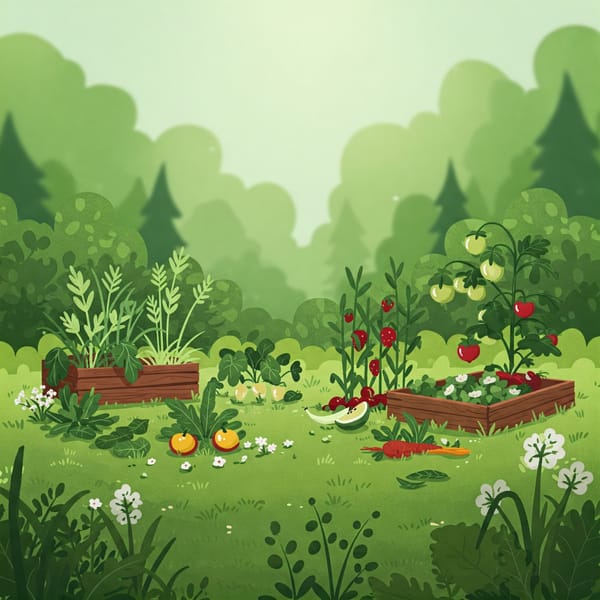Unlocking Nature's Synergy: A Comprehensive Guide to Companion Planting for a Thriving Garden

TLDR
Companion planting is a time-honored gardening technique that involves strategically placing different plant species close together to enhance growth, manage pests, improve soil health, and increase biodiversity. This method relies on ecological principles like nutrient cycling, pest deterrence, and allelopathy (biochemical interactions between plants) to create a more balanced and productive garden ecosystem. Scientific research is increasingly validating the benefits of companion planting, highlighting its potential to reduce reliance on synthetic inputs and promote sustainable gardening practices.
Unlocking Nature's Synergy: A Comprehensive Guide to Companion Planting for a Thriving Garden
Introduction: The Art and Science of Companion Planting
Companion planting, at its heart, is the strategic arrangement of two or more plant species in close proximity to foster mutually beneficial relationships. This practice, also known as intercropping or interplanting in scientific literature, aims to enhance garden health and productivity through a variety of ecological interactions. In an age where sustainable gardening is paramount, companion planting offers a natural and effective way to cultivate thriving gardens while minimizing the need for synthetic interventions.
The Multifaceted Benefits of Companion Planting
The advantages of companion planting are numerous, including:
- Improved Growth and Yields: Synergistic plant pairings can optimize growth and increase overall garden productivity.
- Natural Pest Management: Certain plants repel pests, attract beneficial insects, or act as trap crops, providing natural and effective pest control.
- Attraction of Beneficial Insects: Companion planting supports a diverse ecosystem by attracting beneficial insects that aid in pollination and pest control.
- Potential Flavor Enhancement: Some gardeners believe that specific plant pairings can even enhance the flavor of certain crops.
- Increased Garden Biodiversity: Companion planting fosters a more diverse and resilient garden environment.
- Improved Soil Health and Fertility: Different plants contribute to soil health through nutrient cycling, nitrogen fixation, and improved soil structure.
- Efficient Use of Garden Space: Companion planting maximizes the use of limited garden space by combining plants with different growth habits.
The Scientific Principles Behind Companion Planting
Companion planting is more than just folklore; it's grounded in sound ecological principles:
- Nutrient Cycling: Diverse plant species have varying nutrient needs and can contribute to a balanced soil environment.
- Pest Management: Plants can deter pests, attract beneficial insects, or act as trap crops to protect valuable plants.
- Spatial Interactions: Companion planting optimizes space utilization by combining plants with different growth habits and rates.
- Allelopathy: Biochemical interactions between plants can either promote or inhibit the growth of neighboring species.
Modern scientific research is increasingly validating the effectiveness of companion planting practices, bridging the gap between traditional knowledge and evidence-based understanding.
Synergistic Relationships: Nature's Helping Hand
Many plant pairings exhibit mutually beneficial interactions that enhance garden health and productivity. These synergistic relationships operate through several mechanisms:
- Pest Deterrence: Certain plants release compounds or odors that repel harmful insects. Examples include marigolds, basil, alliums (onions, garlic, chives, leeks), mint, rosemary, sage, dill, lavender, nasturtiums, catnip, and wormwood.
- Nutrient Cycling: Leguminous plants fix atmospheric nitrogen, enriching the soil for themselves and neighboring plants. Deep-rooted plants can also bring up nutrients from deeper soil layers, making them available to shallow-rooted plants.
- Improved Pollination: Planting flowers with vibrant colors and ample nectar attracts pollinators, which are essential for the fertilization and fruit production of many crops.
- Physical Support: Tall-growing plants can provide natural trellises for climbing plants.
- Trap Cropping: Certain plants are used to lure pests away from main crops.
Table 1: Examples of Synergistic Companion Plant Pairings
| Plant 1 | Plant 2 | Mechanism | Benefit for Plant 1 | Benefit for Plant 2 |
|---|---|---|---|---|
| Corn | Beans | Physical Support | Provides climbing structure | Fixes nitrogen in soil |
| Tomatoes | Basil | Pest Deterrence | Repels some pests | May enhance flavor, repels some pests |
| Carrots | Onions | Pest Deterrence | May benefit from soil loosening | Repels carrot flies |
| Squash | Nasturtiums | Pest Deterrence | May benefit from shade | Repels squash bugs, cucumber beetles |
| Lettuce | Tall Plants | Shade Provision | Provides shade | May benefit from reduced competition for resources |
Allelopathy: The Chemical Dialogue of Plants
Allelopathy is the biochemical interaction between plants, where one species releases substances that can either suppress or enhance the growth of others.
- Beneficial Allelopathy: Some plants release compounds that aid in garden health. Examples include rye, marigolds, basil, brassicas, aromatic herbs, sunflowers, and buckwheat.
- Detrimental Allelopathy: Certain plants release compounds that inhibit the growth of neighboring species. Examples include black walnut, fennel, sunflowers, onions, garlic, corn, potatoes, dill, coriander, mint, rue, and strawberries.
Understanding allelopathic interactions is crucial for successful companion planting.
Table 2: Examples of Allelopathic Interactions in Companion Planting
| Plant (Releasing Compounds) | Compound (if known) | Affected Plant(s) | Effect |
|---|---|---|---|
| Black Walnut | Juglone | Tomatoes, Potatoes, Peppers, Eggplants, Azaleas, etc. | Detrimental (growth suppression) |
| Fennel | Unknown | Most other plants | Detrimental (growth inhibition) |
| Sunflower | Allelopathin | Nightshade family, Potatoes | Detrimental (growth inhibition) |
| Rye | Unknown | Pigweed, Common Purslane | Beneficial (weed suppression) |
| Marigold | Thiophene | Nematodes, other plants | Beneficial (nematode suppression, etc.) |
Pest and Disease Management: Nature's Defense System
Companion planting offers a natural approach to managing pests and diseases:
- Pest Control: Companion plants can repel pests, attract beneficial predators, act as trap crops, or disrupt pest behavior.
- Disease Management: Certain plant pairings can help prevent or reduce disease incidence. Increasing garden biodiversity and practicing crop rotation are also vital for disease management.
Soil Health and Nutrient Availability: The Foundation of a Thriving Garden
Companion planting contributes to soil health and nutrient availability through:
- Improved Soil Fertility: Nitrogen-fixing legumes and deep-rooted plants enhance soil fertility.
- Enhanced Moisture Retention: Plants with broad leaves and ground cover plants help retain soil moisture.
- Optimized Nutrient Uptake: Planting species with different root depths and biochemical interactions facilitates efficient nutrient sharing.
Biodiversity and Ecosystem Balance: Creating a Harmonious Garden
Companion planting promotes biodiversity and a balanced garden ecosystem by:
- Supporting Beneficial Insects: Companion plants provide habitat and food sources for predatory and parasitoid insects.
- Attracting Pollinators: A diverse garden attracts pollinators, which are crucial for the reproduction of many crops.
A Journey Through Time: Historical and Cultural Roots
Companion planting has deep historical and cultural roots in traditional agricultural systems worldwide. Examples include the "Three Sisters" method from Indigenous Mesoamerica and the use of aromatic herbs for pest deterrence in various cultures.
Practical Implementation: A Step-by-Step Guide
Successful companion planting requires careful planning and consideration:
- Plant Compatibility: Research beneficial and detrimental plant pairings.
- Optimal Spacing: Consider the mature size and growth habits of each plant.
- Strategic Timing: Implement intercropping and succession planting to maximize space and extend the harvest season.
Companion planting can be adapted to various garden settings, including raised beds, containers, and small gardens.
The Verdict from Science: Examining Current Research
Modern scientific research is increasingly validating the effectiveness of companion planting. Studies have demonstrated practical applications of specific plant pairings, the impact of companion planting on soil health, and the beneficial effects of allelopathy.
Companion Planting Charts: Your Visual Guide
Companion planting charts provide valuable visual aids for gardeners, offering quick reference to beneficial and detrimental plant pairings.
Conclusion: Embracing Nature's Wisdom
Companion planting is a time-tested and scientifically validated approach to enhancing garden health and productivity. By understanding and leveraging the intricate relationships between plants, gardeners can create more resilient, biodiverse, and thriving ecosystems.




